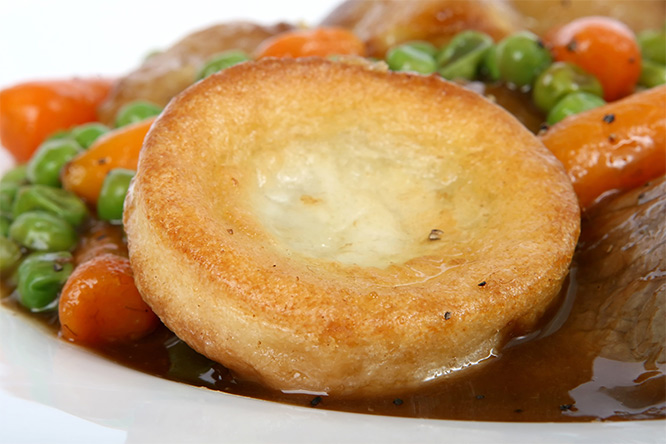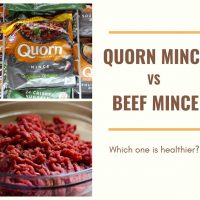Yorkshire pudding is a popular side dish in the UK and in this article, we investigate its nutritional values to see whether it is good for you. We look at things like the calorific content, the amount of fat, and the ingredients. Is Yorkshire pudding a healthy dish or a bad one? Let’s examine the topic in detail.

In this article:
- What is Yorkshire pudding made of?
- Yorkshire pudding nutrition
- Are Frozen Yorkshire Puddings Healthy?
- Are Homemade Yorkshire Puddings Healthy?
- How Many Syns are in a Yorkshire Pudding?
- Are Yorkshire Puddings Fattening?
- Are Yorkshire Puddings Good for Weight Loss?
- Are Yorkshire Puddings Good or Bad for You? – Conclusion
What is Yorkshire pudding made of? (Ingredients)
Supermarket bought Yorkshire puddings can have different ingredients and nutritional values from homemade recipes. Let’s start with homemade Yorkshire pudding ingredients and then compare a few popular UK supermarket, ready-made alternatives.
There are several recipes online you can choose to make Yorkshire puddings at home. For example, this recipe by James Martin, and this recipe found on BBC Good Food network.
James Martin uses 200g of plain flour, 3 eggs, 300 ml of milk, and 4 tablespoons of vegetable oil. The BBC recipe uses the same recipe but exchanges the 4 tablespoons of vegetable oil for 2 tablespoons of olive oil.
Asides from not being vegan (due to the eggs and milk), there’s nothing worrying about these ingredients. We don’t want to get too much oil in our diet, so eating a portion of 2 pieces is considered enough. If you are lactose intolerant, you may wish to substitute the standard milk for soy milk.
We then turned to shop-bought bake at home Yorkshire Puddings to see what their ingredients are.
Tesco also use wheat flour for their puddings which seems to be standard. This wheat flour has been fortified with calcium carbonate, iron, niacin, and thiamine. Niacin is vitamin B3, which helps regulate the digestive and nervous systems. Thiamine is vitamin B1 and helps your body turn food into energy. Tesco also use pasteurised egg whites and whole eggs, rapeseed oil, salt, and sunflower lecithin as the emulsifier to keep the batter silken. Instead of whole milk, they use skimmed milk.
Asda use the same ingredients, but they use double the quantity. Their packs are for 12 pieces whereas Tesco’s are for 6 pieces.
Sainsbury’s version of Yorkshire puddings uses Fortified Wheat Flour too, with that calcium carbonate building bones and muscles. The Sainsbury’s difference is in the free-range eggs they use.
As you can see, the ingredients for shop-bought Yorkshire puddings are all similar.
Now, let’s look at the nutritional values to find out just how healthy Yorkshire puddings are.
Yorkshire Pudding Nutrition
Shop bought Yorkshire puddings have around 1.4g of sugars per 2 piece portion and contain around 1.6g-2g of fibre. This means they are low in sugar and not so high in fibre. At least, they won’t contribute much to your recommended daily fibre intake of 21-38g.
Yorkshire puddings contain around 4.4g of protein per 2-piece portion which is about 8% of your recommended amount per day. However, homemade Yorkshire puddings contain 9g of protein for the same portion.
Homemade Yorkshire puddings have 3g of sugar, about double that of the store-bought versions.
Fat content
The standard supermarket recipe (that’s fortified wheat flour, eggs, milk, oil, salt, and soya lecithin) has less than 3g of fat per oven-baked pudding (2.1g in Sainsbury’s Yorkshire pudding and 2.8g in Tesco’s one). This is 3%-4% of your daily fat allowance per single pudding.
Both, Tesco’s and Sainsbury’s Yorkshire puddings contain only 0.2g of saturated fat. This is very low and good news for those avoiding saturated fat in order to reduce their blood cholesterol levels.
If a portion is two puddings, this translates to 4.2g-5.6g of fat, or 6%-8% of your daily allowance.
Per 100g, supermarket-bought Yorkshire puddings contain just over 10g of fat. This means they contain moderate amounts of fat. According to NHS, they are not low in fat, but also not high.
When it comes to homemade Yorkshire puddings (BBC Good Food recipe), they contain 9g of fat per 2 pudding portions. This is higher than the 4.2g of fat per portion for the store-bought recipe. This means homemade Yorkshire puddings contain more than twice the fat of store-bought ones.
Only 0.4g of fat in the store-bought ones is saturated fat, while the homemade version has 3g saturated fat per serving of 2 puddings. Too much saturated fat is bad for you because it raises your cholesterol levels.
It seems that one of the reasons for fat content differences between homemade and shop-bought Yorkshire puddings is due to the use of full-fat milk in homemade recipes.
How Many Carbs are in a Yorkshire Pudding?
Two Sainsbury’s puddings equal 16.8g of carbohydrates, which is high for the size of the portion. It is like one and a half slices of bread.
Tesco’s puddings contain even more per serving – 19.6g of carbs and Asda’s one contain 14.4g per serving.
When it comes to homemade Yorkshire Puddings, both recipes cited a 2 pudding portion of 28g of carbohydrates.
We, therefore, determine that frozen/shop-bought Yorkshire puddings have fewer carbs than homemade ones. Unless, of course, you are buying giant Yorkshire Puddings.
Giant Yorkshire Puddings have 359 calories, 11g of fat – of which 1.2g is saturated – and a whopping 54g of carbohydrates. It is recommended that we eat between 225 and 325g of carbs each day so these are very high in carbs.
Yorkshire Pudding Calories
Homemade Yorkshire puddings contain around 224-240 calories per two-pudding portion.
Shop-bought Yorkshire Puddings have only 126 calories per portion or even less, depending on which brand you buy. This means that homemade Yorkshire puddings are higher in calories. If you add gravy to them (which is essential as they are not traditionally eaten dry) you could add further 123 calories.
To reduce calories in homemade Yorkshire puddings, use skimmed milk instead of full-fat one. You could also try using less fat.
FAQs: Are Yorkshire Puddings Healthy?
In this section, we will attempt to answer some frequently asked questions about the calories, fat, and nutritional information in Yorkshire Puddings.
Are Frozen Yorkshire Puddings Healthy?
Frozen Yorkshire puddings are made with eggs, fortified flour, and milk. They are not unhealthy if eaten in moderation and as part of a balanced meal. They are a little high in both carbohydrates and fat but contain less fat than homemade Yorkshire puddings where full-fat milk is normally used. They contain very small amounts of saturated fat which is healthier. A portion of 2 is considered appropriate.
Are Homemade Yorkshire Puddings Healthy?
If you follow one of the top Yorkshire pudding recipes online, you will make Yorkshire puddings with higher fat content than frozen or shop-bought ones. These puddings will also have more carbohydrates but will be higher in protein. They will have more saturated fat than store-bought options so, they won’t be as healthy. However, you can make them healthier by using skimmed milk instead of full-fat milk.
How Many Syns are in a Yorkshire Pudding?
If you use the Slimming World Yorkshire puddings recipe there are only 2 syns per pudding.
If you buy Yorkshire puddings from a supermarket, the number of syns per one pudding vary depending on a brand and size of a pudding. For example, there is only 1 syn in Aunt Bessies Mini Yorkshire and 2 syns in Aunt Bessies Golden Yorkshire.
In Aldi Everyday Essentials Yorkshire Pudding there are 2.5 syns and there are 3 syns in Asda Yorkshire Pudding.
Are Yorkshire Puddings Fattening?
Yorkshire puddings can be fattening depending on their size and how many you eat. If you stick to the recommended 2 pieces a portion, this will not represent too many calories and fat in relation to your daily allowance. However, once you start adding things like gravy to them, this will make your meal more calorific and higher in fat. It’s best to keep your portions small to avoid consuming excess calories in one meal and gaining weight over time.
Also, watch the size of your pudding! When we increase the size to the giant Yorkshire puddings, we start to see that they are really fatty (11g of fat, 1.2g saturated fat, 54g carbohydrates.)
Also keep in mind that homemade Yorkshire puddings have more fat than shop bought or frozen ones from UK leading supermarkets unless you use skimmed milk in your homemade recipe.
Are Yorkshire Puddings Good for Weight Loss?
Yorkshire puddings can be eaten in moderation as part of a healthy and balanced weight loss diet. If you make them at home from scratch, use skimmed milk and low-calorie cooking spray to reduce their calories and fat content. Making them this way counts as 2 syns each in the Slimming World diet.
If you buy them from a supermarket, check how many calories they have each and choose the ones that are lower in calories and fat per 100g.
While it’s perfectly fine to eat Yorkshire puddings when trying to lose weight, you need to control your portion size and remember that shop-bought Yorkshire puddings are normally better for weight loss than homemade ones unless you follow the Slimming World recipe.
Instead of focusing on one type of food, look at your diet as a whole and make sure it contains more foods that will help you lose weight and fewer foods that are fattening and high in sugar.
Conclusion – Are Yorkshire Puddings Good or Bad for You?
Yorkshire puddings contain moderate amounts of fat and very little sugar. They contain some saturated fat, which can raise cholesterol when eaten in excess, however, their saturated fat content is low and does not raise any concerns.
Yorkshire puddings are not high in fibre which is beneficial for our digestion and this is due to the white flour used to make them.
We come to the conclusion that they are not the worst food you can eat and can easily be eaten as part of a healthy and balanced diet as long as you don’t eat too many in one go (stick to 1-2 puddings per meal maximum).
To eat healthier Yorkshire puddings, make them at home using skimmed milk and low-calorie cooking spray. Like this, you will reduce calorie and fat content significantly and easily include them as part of your weight loss diet.



